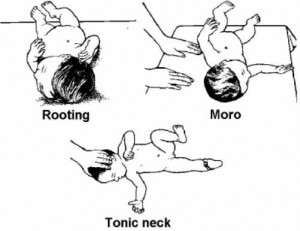The newborn infant exhibits remarkable sensory development and an amazing ability for self-organization in social interactions.
The infant’s muscles are firm and resilient. He has the ability to contract when stimulated, but lacks the ability to control them. He wiggles and stretches, but movements are uncoordinated.
a. Cephalo-Caudal (Head to Toe) in Development.
Gross motor development occurs first, followed by finer motor development. Reflex actions present at birth serve the infant until neuromuscular development is improved. Absence of reflex activity often indicates some form of brain damage.
b. Common Infant Reflexes. See figure 7-8.
(1) Rooting. The infant turns his head to the side when the side of his face is touched.
(2) Moro reflex. The infant’s total body responds to a startling event. His arms extend out and up, legs flex toward abdomen. This reflex is usually lost by three months of age.
(3) Tonic neck reflex. The infant assumes a fencer’s position. His arm and leg on one side is extended, the opposite side is flexed. His head is turned toward extended side. This is not evident after four months of age.

